
How Does Bedtime Yoga Enhance Wellness? Best Yoga Poses That Work
- November 23, 2023
- Scientific Insights
- 0 Comments
Bedtime Yoga for Better Sleep and Well-being: Insomnia yoga poses help you get a sweet dream.
Table of Contents
Quality sleep and mental health are the dynamic duo of a thriving life. But how do we supercharge these vital elements?
The answer is bedtime yoga—a rising star in holistic well-being.
Performing yoga exercises before going to bed not only helps you sleep better and deeper but also relieves stress, reduces pain, and improves the nervous system.
Bedtime yoga is not just a trend; it’s a powerful ally for those seeking a profound relationship between sleep and mental well-being.
Let’s join Mental Mapguide to learn about the benefits of practicing yoga before bed and the best exercise positions.
Why is Yoga so Effective in Treating Insomnia?
In this tech-filled world of ours, where Wi-Fi never takes a break, lives are all tangled up, and getting a good night’s sleep can feel like a real challenge.
Getting lost in the social media universe with Instagram, TikTok, or Twitter will easily mess with your sleep.
So, maybe you’ve tried everything—new diets, hitting the gym, perhaps even a few sleep meds. But for some reason, it does not work for you.
And that’s also why many people find a better solution like Yoga.
Yoga is a practice originating from India. This discipline requires practitioners to coordinate physical movements with breathing and thinking. Yoga postures that help cure insomnia are based on the theory of yin and yang.
Doctors say that physical activity can increase blood circulation and improve health, there by positively affecting the brain’s rest process.
With simple and gentle postures suitable for all people and ages, yoga is gradually becoming the top choice of many people. Besides the health benefits, yoga also helps practitioners relieve stress, helping the mind become comfortable and relaxed.
Bedtime Yoga and Connection Between Your Body and Mind
Do you know how bedtime yoga is not just about stretching but a real mind and body connection?
It’s like a magic potion for mental calmness, setting the stage for the sweetest dreams.
Scientific studies prove that bedtime yoga doesn’t just chill your mind but actually changes your body. It’s like turning down the stress and cranking up the relaxation vibes.
The intentional stretching and relaxation techniques used in different poses specifically target areas where stress tends to get, like the neck, shoulders, and lower back.
Through gentle and deliberate poses, the physical movement and conscious breathing combine to create a union that goes beyond relaxation.
This not only helps you feel physically more comfortable but also contributes to the mental relaxation needed for a peaceful night’s sleep.
Let’s talk about mindfulness a little bit.
It’s the secret sauce in bedtime yoga. Being present at the moment is the key, and when you throw in some meditation, it’s like giving your mind a cozy blanket before bedtime. Picture your mind becoming this chill sanctuary, far away from the chaos of daily life.
In addition to treating insomnia, Bedtime yoga also has a number of positive effects on health. May be mentioned as:
- Enhance concentration ability
- Reduce stress
- Stabilize mood
- Beautify and healthy skin
- Help your body stay slim
- Have a happy life
- Enhance blood circulation
So, don’t just take our word for it—give bedtime yoga a shot and let the good sleep vibes roll in!
Yoga Poses for Improved Sleep and Mental Well-being
Adding a mindful yoga routine to your evening ritual can work wonders for improving your sleep and mental well-being. With intentional movements and deep breathing, you can create a soothing prelude to bedtime, releasing tension and fostering a sense of calmness.
Let’s delve into five yoga poses that improve your sleep quality and mental well-being.
1. Child’s Pose (Balasana):
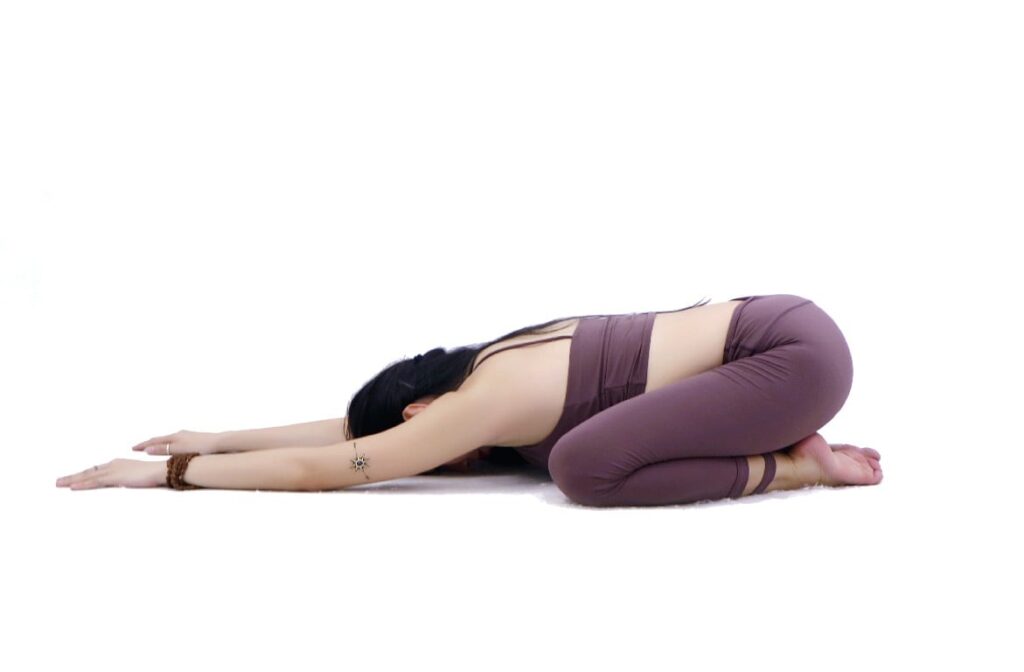
- Begin by kneeling on the mat with your big toes touching and knees spread comfortably apart.
- Sit back on your heels and extend your arms forward, lowering your chest toward the mat.
- Rest your forehead on the ground and breathe deeply, allowing your spine to lengthen and your shoulders to relax.
- Child’s Pose gently stretches the back, hips, and thighs, promoting a sense of surrender and release. The forward bend encourages a soothing effect on the nervous system, making it an ideal pose to calm the mind before bedtime.
2. Legs Up the Wall Pose (Viparita Karani):
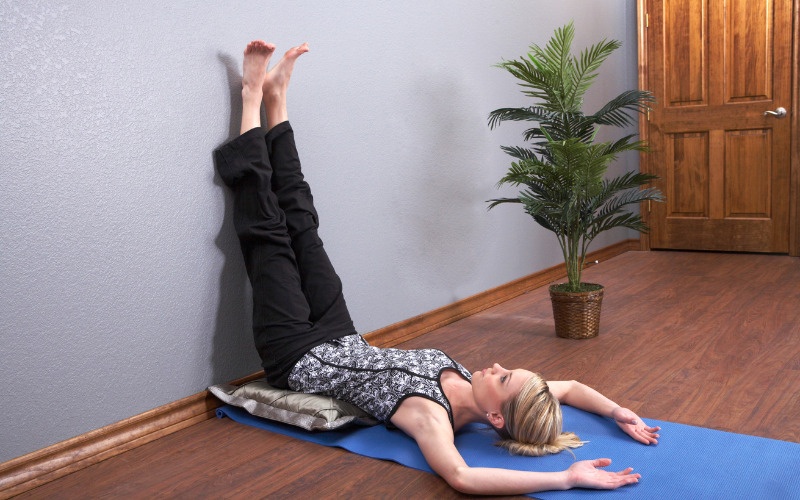
- Sit with your side against a wall and swing your legs up, lying on your back with your buttocks close to the wall.
- Extend your arms out to the sides, palms facing up, and relax your shoulders into the mat.
- Close your eyes and focus on slow, deep breaths, allowing the gentle inversion to ease tension in the legs and lower back.
- Legs Up the Wall Pose promotes relaxation and encourages blood flow to the brain, helping to alleviate stress and anxiety. This restorative inversion also has a calming effect on the nervous system, making it beneficial for those seeking improved sleep quality.
3. Corpse Pose (Savasana):
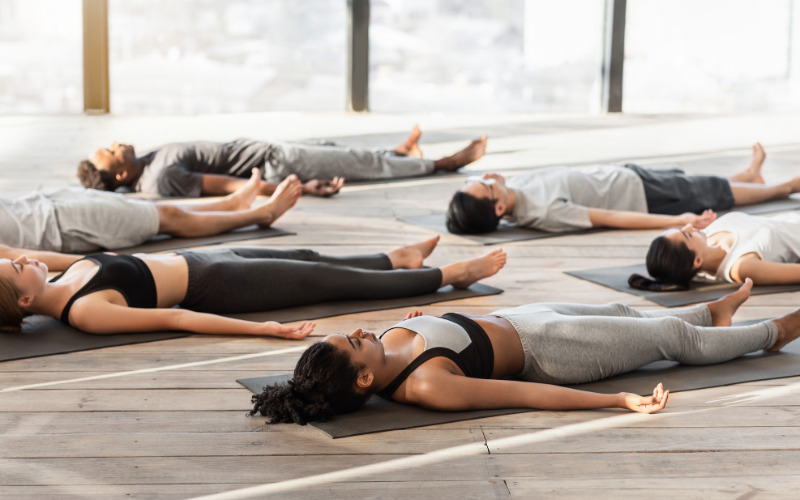
- Lie on your back with your legs extended and arms at your sides, palms facing up.
- Close your eyes and bring awareness to your breath, allowing your body to sink into the mat.
- Focus on releasing tension from each part of your body, starting from your toes up to the crown of your head.
- Savasana, or Corpse Pose, is a classic relaxation pose that encourages deep rest and rejuvenation. By consciously surrendering to the stillness, this pose helps quiet the mind and prepares the body for a peaceful night’s sleep.
4. Seated Forward Bend (Paschimottanasana):
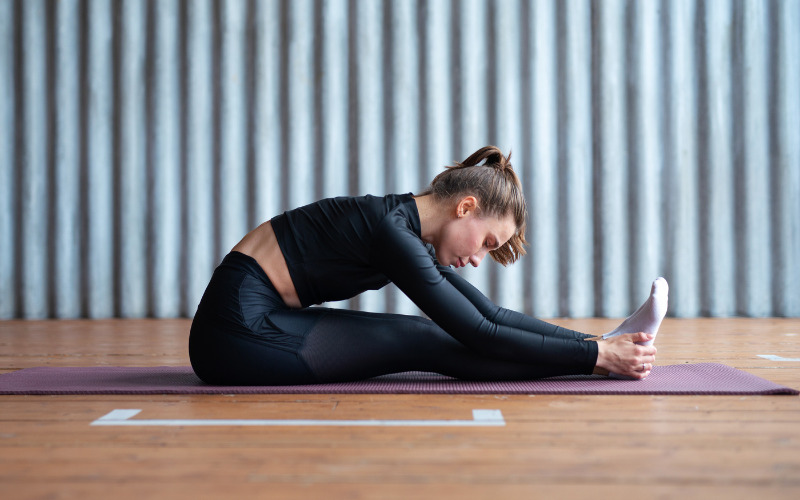
- Begin by sitting on the mat with your legs extended in front of you.
- Inhale as you lengthen your spine, and then exhale as you hinge at your hips, reaching forward towards your feet.
- Hold onto your shins, ankles, or feet, depending on your flexibility, and allow your head to relax towards your knees gently.
- Seated Forward Bend stretches the spine, hamstrings, and lower back. This pose calms the nervous system, relieving stress and anxiety. As you fold forward, focus on the breath, allowing it to guide you into a state of relaxation, making it an excellent addition to your bedtime yoga routine.
5. Reclining Bound Angle Pose (Supta Baddha Konasana):
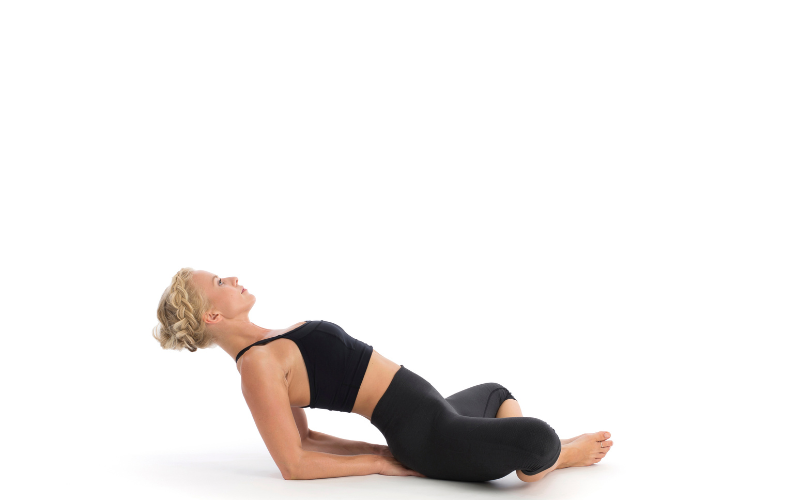
- Lie on your back and bring the soles of your feet together, allowing your knees to fall open to the sides.
- Support your knees with props if needed, ensuring a comfortable and relaxed position.
- Place your hands on your belly or extend your arms out to the sides, palms facing up.
- Reclining Bound Angle Pose opens the hips and groin, releasing tension from these areas. It also invites a sense of surrender and ease, making it beneficial for calming the mind. This pose encourages a gentle chest opening, promoting deep breathing and relaxation—a perfect way to wind down and prepare for a peaceful night’s sleep.
Tips Bedtime Yoga: A Beginner’s Guide to Safe Start
1. Start Simple, Grow Gradually:
As a bedtime yoga newbie, think of yourself as a yoga explorer. Begin with straightforward poses that feel comfortable. Simple stretches and gentle movements are your best companions in the early stages. No need to rush; let your comfort guide you.
Over time, as you get more comfortable, you can gradually amp up the complexity and duration of your bedtime yoga sessions.
2. Listen to Your Body
:
Your body is like the ultimate guide on this yoga journey. Pay attention to how it feels during and after each pose. If something doesn’t feel right, it’s okay to ease off or skip it altogether.
The goal here is to create a calming bedtime ritual, not to transform into a yoga master overnight. So, listen to those signals your body sends—its language is one of comfort and well-being.
3. No Need to Overexert
Remember, bedtime yoga is all about relaxation, not exhaustion. It’s not a competition or a race. Resist the urge to push yourself too hard, especially if you’re just starting.
The magic happens in the gradual, gentle movements and intentional breaths. As you navigate the poses, keep in mind that it’s perfectly okay to take it slow and savor the process.
4. Embrace the Ritual, Not the Complexity
Yes, you don’t need to be a yoga guru to enjoy bedtime yoga. The goal is not to master intricate poses right away. Instead, focus on building a simple, soothing bedtime ritual that works for you.
As you become more familiar with bedtime yoga, you can explore additional poses, but there’s no rush. It’s all about the journey, not the destination.
Conclusion
In a nutshell, bedtime yoga is like a friendly bedtime routine that’s good for your mind and helps you sleep better. People love it, and science says it’s great too! It’s like a magical way to make your mind calm and happy before sleep. So, when you do bedtime yoga, think of it as your secret to having really nice dreams.
And by the way, if you want more cool tips, check out Mental Mapguide. It’s like a guide for your mind that helps you feel awesome. Sweet dreams!






